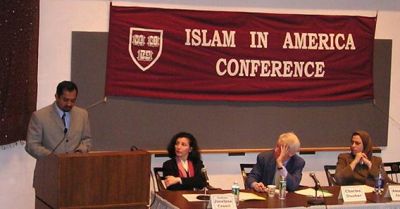
I was glad to have that background when I read a fantastic piece in The New York Times by Andrea Elliott. She uses the story of how two different imams bridged their cultural divides to show the tensions among Muslims in America. One imam, a first-generation Muslim, serves a congregation of American blacks while another, a first-generation American, serves a congregation of Arabs and Asians:
For many African-American converts, Islam is an experience both spiritual and political, an expression of empowerment in a country they feel is dominated by a white elite. For many immigrant Muslims, Islam is an inherited identity, and America a place of assimilation and prosperity. . . .
African-Americans possess a cultural and historical fluency that immigrants lack, said Dr. [Faroque] Khan; they hold an unassailable place in America from which to defend their faith.
For Imam [Al-Hajj] Talib, immigrants provide a crucial link to the Muslim world and its tradition of scholarship, as well as the wisdom that comes with an "unshattered Islamic heritage."
The article does mention that black American Muslims trace their roots to the arrival of West African slaves in the South. Elliott also mentions the Nation of Islam and other movements in the early 20th century. She mentions the racism of these groups and their negative reception by Muslims overseas. Some of these groups eventually aligned with Sunnis. I wish we knew more about the theological differences between the historic American Muslim groups and Sunnis. I also wish we knew more about the theological differences between the two groups profiled by Elliott. It's mostly a story about social and political differences.
One interesting detail -- in a story full of interesting details -- was that the sexes worship separately in the American Musim mosque while the immigrant mosque has no partition for the sexes. At the immigrant mosque, sermons are given in English and most female worshipers do not cover their heads outside of the mosque.
I was pleasantly surprised by how well the religious angles were woven into another story on Muslim families dealing with tragic death. It turns out that the two families that lost nine family members last week in a Bronx row house were Muslim. Reporters Timothy Williams and Manny Fernandez look at a community that has rallied around immigrant families facing unspeakable grief:
Visiting the mosque was a public ritual, but there were private ones, too. At a crowded apartment in a Bronx housing complex, friends and relatives of the Soumare and Magassa families -- women and children only -- sat on the couches, beds and even the floors, quietly mourning together at the home of an aunt of Fatoumata Soumare, who died in the blaze.
People whispered in the three-bedroom apartment, the television news in the background. No one raised their voices. Women cooked rice and chicken, cutting chunks of goat meat.
They described it as a Muslim tradition, the women mourning together and the men mourning together, separately for now.
Last week we highlighted a story about a polygamous family in Utah. One reader wondered whether polygamy was now legal in the United States since the family was identified by name and apparently feared no repercussion. This story, while not about polygamy, had a fascinating tidbit about the same that provoked more questions than answers:
[Moussa] Magassa has two wives. His wife Manthia was uninjured but lost five children; she spent much of yesterday with him. His wife Aisse jumped to safety, breaking a leg. Her four children lived. She remains in intensive care. Two other children were thrown to safety, caught by neighbors who ran to the building as it was consumed by flames and smoke.
Polygamy is forbidden by law in this country, right? So in what sense does Magassa have two wives? Presumably he took his multiple wives under Sharia or another legal system. But how does this work for an immigrant? A bit of explanation is definitely in order.
Anyway, this isn't a religion story per se, it's a local story about a major event. But like so many stories that we read about each day, the players are religious and are existing in a notably religious realm. I think far too many reporters shy away from details about religion, which is unfair to readers and just makes stories less interesting. When the reporters delve into the funeral details -- mentioning how even non-Muslims in the community are helping with arrangements -- they include the note that usually Muslim funerals are held within 24 hours. Just seamlessly placed into the story. A good show on both counts from The New York Times.
